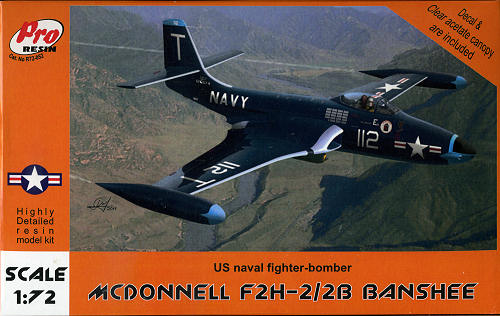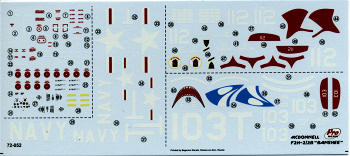
| KIT #: | R72-052 |
| PRICE: | $ |
| DECALS: | Two options |
| REVIEWER: | Scott Van Aken |
| NOTES: | Resin with vacuformed canopies |

| HISTORY |
The McDonnell F2H Banshee was a single-seat carrier-based jet fighter aircraft deployed by the United States Navy and United States Marine Corps from 1948 to 1961. It was one of the primary American fighters used during the Korean War and was the only jet-powered fighter ever deployed by the Royal Canadian Navy, serving the RCN from 1955 until 1962. The aircraft's name is derived from the banshee of Celtic mythology.
Despite the Navy's accepting the F2H-1, it was the more capable F2H-2 that was most widely used. With newer Westinghouse J34-WE-34 3,250 lbf (14.5 kN) thrust engines, it had improved performance. The wing was modified and strengthened to add provisions for 200 gal (760 l) wingtip fuel tanks; unlike the contemporary USN F9F Panther, the Banshee's wingtip tanks were detachable. Two armament pylons were added under each stub and outboard wing, for a total of eight, allowing the aircraft to carry a maximum stores load of 1,580 lb (454 kg), consisting of four 250 lb (113 kg) bombs and four 5-in (12.7 cm) unguided rockets. The “kneeling” nose gear was omitted from the F2H-2 and most other subsequent Banshee variants.
The F2H-2 was the foundation for three minor variants of the Banshee. The first, the F2H-2B, had strengthened wings and a strengthened inner pylon under the port-side wing to allow the craft to carry a 1,650 lb (748 kg) Mark 7 nuclear bomb or a 3,230 lb (1,465 kg) Mark 8 nuclear bomb. In order to compensate for the vastly increased load, the F2H-2B was fitted with stiffer landing gear struts and a pilot-switchable power booster for the ailerons; the latter was necessary so pilots could control a roll to the left with a heavy Mark 8 nuclear bomb fitted on the left-hand pylon. One 20 mm cannon was omitted to make room for additional electronics to arm the nuclear weapon. 333 F2H-2 and F2H-2B aircraft were built.
| THE KIT |
 ProResin kits have always been well molded and generally fit quite well. Their tan resin is fairly free from any casting errors, though one does find a pin hole from time to time. These parts are all in a sealed polybag and due to the weight of some of the parts, it is not uncommon to find some of the smaller bits have broken away from the pour stubs, though this one seemed to miraculously survive international mails with no problem.
ProResin kits have always been well molded and generally fit quite well. Their tan resin is fairly free from any casting errors, though one does find a pin hole from time to time. These parts are all in a sealed polybag and due to the weight of some of the parts, it is not uncommon to find some of the smaller bits have broken away from the pour stubs, though this one seemed to miraculously survive international mails with no problem.  Instructions are well done with color references in Humbrol, Modelmaster and Revell paints. The two options are overall gloss sea blue, including the wells, gear and struts. These aircraft had unpainted metal leading edges and tank tips. Markings are well printed, but here is a quandary. My kit came without instructions or a painting guide. An e-mail to ProResin got a scan of the instructions with a promise of a scan of the markings guide "in a few days". Several e-mails and many weeks later, still no markings guide. It seems that there are markings for two planes. I can see right away that there is a problem. If the box art plane is correctly marked, then the decals have the trim in the wrong color. E-mails from those who know more than I have verified that the decal sheet is correct in the colors being used. There is an ancient decal sheet by Microscale on the Banshee that fits the Airfix kit. It may be useful to hunt that one up if you wish other options.
Instructions are well done with color references in Humbrol, Modelmaster and Revell paints. The two options are overall gloss sea blue, including the wells, gear and struts. These aircraft had unpainted metal leading edges and tank tips. Markings are well printed, but here is a quandary. My kit came without instructions or a painting guide. An e-mail to ProResin got a scan of the instructions with a promise of a scan of the markings guide "in a few days". Several e-mails and many weeks later, still no markings guide. It seems that there are markings for two planes. I can see right away that there is a problem. If the box art plane is correctly marked, then the decals have the trim in the wrong color. E-mails from those who know more than I have verified that the decal sheet is correct in the colors being used. There is an ancient decal sheet by Microscale on the Banshee that fits the Airfix kit. It may be useful to hunt that one up if you wish other options. | CONCLUSIONS |
It all makes for a nice model and an interesting comparison to the ancient Airfix kit. Many of us were hoping that a more modern injected plastic kit would be available, but it is hard to beat the detail in this ProResin kit. Recommended for experienced modelers due to the small parts.
| REFERENCES |
February 2012
Thanks to ProResin for the preview kit. If your dealer does not carry it, have them order it for you.
If you would like your product reviewed fairly and fairly quickly, please contact the editor or see other details in the